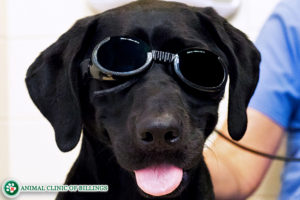Physical Rehabilitation and Laser Therapy
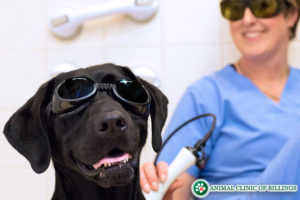
Physical rehabilitation utilizes therapeutic exercise and a variety of other methods to improve function and promote healing. It helps to decrease pain, improve cardiovascular fitness, increase joint mobility, muscle strength, and endurance.
Companion animals, like their humans, often require physical rehabilitation to recover the ability to walk, regain the use of a limb, and to promote overall well-being after a serious injury or major orthopedic or spinal surgery.
Those of us who have experienced an injury or surgery know how beneficial physical therapy can be. Rehabilitation exercises lessen pain, strengthen muscles, and speed up the recovery process, helping the body to get back into shape after a traumatic event.
CANINE PHYSICAL THERAPY CENTER
Our Wellness and Physical Conditioning Program has been specifically developed for dogs that need more exercise, are overweight, need enhanced strength, or to alleviate chronic pain. Common indications for physical rehabilitation therapy include:
- hip and elbow dysplasia
- gait abnormalities
- spinal cord injuries and surgeries
- spine disorders such as intervertebral disk disease or IVDD
- bone and joint injuries and surgeries
- arthritis/degenerative joint disease (DJD)
- obesity or overweight and out of shape pets
- soft tissue injuries of the ligaments, tendons, and muscles
- pets with chronic diseases like osteoarthritis
- amputation recovery
- former Physical Rehabilitation Therapy patients
- working and sporting dogs to promote optimal performance
- post-surgical recovery of the knee, hip, back or neck
- being hit by a car or other serious trauma-related injuries
- rear limb weakness
- paralysis
- neurological disorders, such as degenerative myelopathy
- nerve disorders, such as fibrocartilaginous embolism or FCE and vestibular disease
This just goes to show that physical therapy isn’t just for humans anymore. Veterinary rehabilitation is widely regarded as the fastest growing area in veterinary medicine, and the number of practices offering rehabilitation services continues to grow.
Physical rehabilitation is prescribed to address issues in dogs and cats such as pain, loss of mobility, and joint damage. Often these are a result of a musculoskeletal injury, arthritis, recovery from orthopedic surgery, obesity, neurological disease, paralysis, and more.
What are Physical Rehabilitation treatment methods for dogs?
To accomplish our treatment goals, we use a combination of:
- Massage
- Swimming
- Therapeutic Laser Therapy
- Therapeutic Ultrasound
- Neuromuscular Electrical Stimulation
- Weight Shifting and Balance Activities
- Transcutaneous Electrical Nerve Stimulation (TENS)
- Low Impact Exercise on Land and Water
- Manual Therapy or Joint Mobilization
- Range of Motion Exercises (ROM)
- Underwater Treadmill
- Acupuncture
- Heat Application
- Cold Pack Application
- Rehabilitation Stem Cell Therapy
- Obstacle course exercises
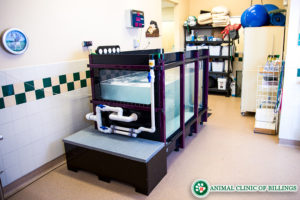
Can healthy dogs benefit from physical therapy?
Absolutely! Even healthy dogs and cats have canine or feline PRT as part of their regular exercise regime. This is especially popular when the weather makes it difficult to work out – in both the cold of the winter or the heat of the summer.
The underwater treadmill is a wonderful cross-training tool and is beneficial to any dog’s program. For example, the Animal Clinic of Billings works with performance dogs that come in once or twice a week to exercise in the underwater treadmill for thirty to forty-five-minute sessions. We also have dogs that have undergone rehabilitation visit us once or twice weekly for underwater treadmill sessions.
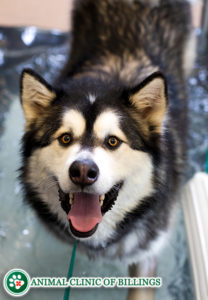
BENEFITS OF PHYSICAL THERAPY FOR DOGS
- decreased pain
- promote healing
- improve function
- increase endurance
- increase joint mobility
- increase muscle strength
- improve cardiovascular fitness
- increase flexibility
Canine physical therapy helps our furry friends in so many ways including increasing function by enabling the pet to use all of his or her limbs to move around and participate in daily life; decreasing pain due to chronic osteoarthritis or a recent surgery or injury; and, encouraging healing of a wound, a fracture, or a sprain/strain.
Physical rehabilitation therapy for dogs continues to evolve to enhance surgical recovery and maintain a comfortable quality of life for veterinary patients in both dogs and cats alike.
The Animal Clinic of Billings conditioning for wellness program
The Conditioning for Wellness Program focuses on overall fitness for:
- Overweight and out of shape pets
- Former Physical Rehabilitation Therapy patients
- Pets with certain chronic diseases like osteoarthritis
- Working and sporting dogs where the goal is to promote optimal performance
Call 406-252-9499 to ask one of our PRT specialists about our conditioning for wellness program for dogs.
Laser Therapy for dogs and cats
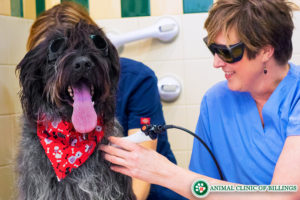
What is laser therapy for dogs and cats, and how does it work?
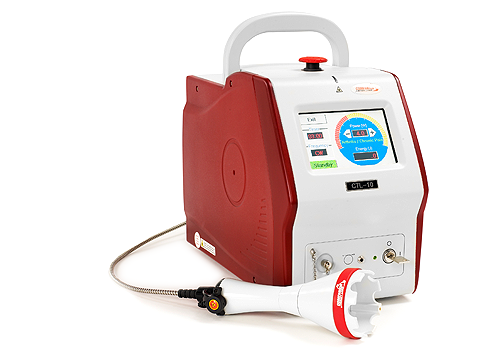
At the Animal Clinic of Billings and Animal Surgery Clinic, we are always searching for new ways to care for your dog or cat after surgery, especially whenever pain is concerned. Veterinary laser therapy is an effective form of treatment for many medical ailments that affect dogs, cats, and humans alike. The laser treatment itself promotes faster healing by increasing the circulation within the affected area of the body. This contributes to a cleaning of the injured tissues while simultaneously stimulating the dog or cat’s cellular metabolism, and ultimately, help to decrease pain significantly.
Veterinary laser therapy provides dogs and cats a pain-free, drug-free, and surgery-free, form of treatment that can be performed in conjunction with other existing forms of treatment and pain management.
When should laser therapy be used on dogs and cats?
Laser therapy can be used on dogs and cats to treat a multitude of ailments. These include:
- Post-surgical and soft tissue trauma
- Muscle, ligament and tendon ruptures or injuries
- Back pain and swelling
- Gingivitis
- Ear infections
- Open wounds and hot spots
- Arthritis / hip dysplasia / elbow dysplasia
- Anal gland infections
- Degenerative disc disease and ruptured vertebral discs
Many of our veterinary laser therapy patients are older dogs and cats with musculoskeletal ailments. Some signs that your feline or canine senior companion is experiencing pain or discomfort can often include:
- Circling multiple times before lying down
- Abnormal sitting or lying posture
- Restlessness
- Limping, or unable to stand up or lie down
- Whining, groaning or other vocalizations
- Difficulty getting into car or down stairs
- Won’t wag tail
- Lack of grooming
- Lack of appetite
- Trembling
- Licking or biting area
Pain relief for dogs and cats
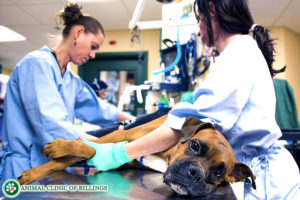
Pain is a common side effect of many ailments we are able to treat through laser therapy, and veterinary laser treatments are an excellent way to provide pain relief to your canine or feline companion. Most often, the first sign that the therapy is working when a dog or cat begins a laser therapy session is the animal will suddenly relax, definitively indicating that their pain is subsiding. Many of our clients notice their dog or cats sleeps better after a laser therapy session. We attribute this to a dramatic decrease in their pain and discomfort.
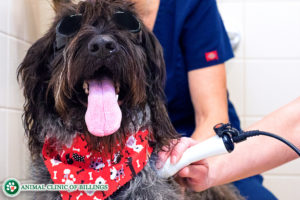
The process in which laser therapy reduces a dog or cats pain is called Òvasodilation, which means, the opening of blood vessels. Òvasodilation reduces inflammation and activates the lymphatic drainage system, which allows the dog or cats body to begin draining any swollen areas targeted with the laser. This results in a reduction of the swelling, and in turn, reduces the amount of pain felt by the animal.
Veterinary laser therapy also stimulates a dog or cats nerve cells that serve as pain blockers, and prevent those signals from being transmitted to the dog or cats brain. Less inflammation, swelling, and the blocking of pain signals to the brain all work together as equal contributors in reducing the amount of pain the animal is experiencing. Additionally, laser treatments also stimulate the production of high levels of naturally-produced endorphins in dogs and cats, which counteract the animal’s pain even further.
How dog and cat laser therapy works
A therapeutic veterinary laser concentrates an intense beam of light particles (photons) to penetrate deep into a dog or cats tissues and stimulate cells to heal safely and painlessly. The concentrated photons produce ATP through a chemical change called photo-bio-modulation to stimulate mitochondria within the cells of the dog or cats body
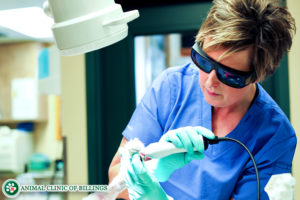
ATP provides the energy needed for tissue to heal. By increasing ATP production, we see a reduction in inflammation and pain, and an acceleration in tissue repair, cell growth, blood flow, healing, and nerve function.
Another amazing feature of laser therapy treatment on dogs and cats is that there are no known side effects, and most animals experience positive results immediately. It’s FDA-approved, and clinically proven to be effective in treating a number of health conditions in dogs, cats, and other animals.
Laser therapy on dogs and cats to recover from injury or surgery
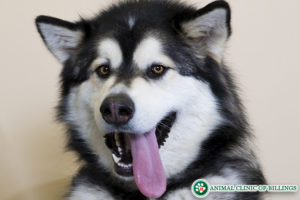 Laser therapy is an extremely effective and helpful tool for any major postoperative recovery protocol. In minor cases, laser therapy treatments alone can sometimes be all that is needed to properly alleviate the animals pain and stimulate cell growth and the healing process. Because the laser can easily target the precise area that’s injured or affected without the animal being required to move, it can speed up healing, strengthen muscle and tissue, and improve mobility in lieu of the animals inability to exercise, and ultimately, enhance your dog or cat’s overall quality of life almost immediately.
Laser therapy is an extremely effective and helpful tool for any major postoperative recovery protocol. In minor cases, laser therapy treatments alone can sometimes be all that is needed to properly alleviate the animals pain and stimulate cell growth and the healing process. Because the laser can easily target the precise area that’s injured or affected without the animal being required to move, it can speed up healing, strengthen muscle and tissue, and improve mobility in lieu of the animals inability to exercise, and ultimately, enhance your dog or cat’s overall quality of life almost immediately.
Is laser treatment for dogs or cats painful?
Laser therapy treatment is both comforting and pain-free. All the dog or cat will feel from a laser therapy treatment session is a gentle, relaxing, warm, or tingling sensation if they feel anything at all. If the animal is experiencing any anxiety going into his or her laser therapy session, typically that anxiety and tension subsides as the pain your dog may be experiencing begins to dissipate.
Does laser therapy have any side effects on dogs or cats?
Laser therapy treatments do not have any known side effects on dogs or cats. It’s considered to be extremely safe and very effective across the entire veterinary industry.
If your dog or cat has been diagnosed with any of the following medical conditions, ask your veterinarian about laser therapy treatments:
- Hip dysplasia
- Arthritis
- Skin conditions like hot spots and dermatologic infections, disorders, interdigital dermatitis, and lick granulomas
- Post-surgery pain management, especially for spaying and neutering
- Pain management for sprains
- Scar tissue therapy
- Dental care
- Wound treatment
- Degenerative joint disease (arthritis)
- Back pain/disc disease
- Post-surgical healing/pain relief
- Tendonitis
- Otitis externa (ear infections)
- Sprains and strains
Our veterinarians and physical therapy practitioners may be able to reduce inflammation and the pain your dog or cat is experiencing as a result of these conditions. We highly recommend that you have your dog or cat evaluated by a veterinarian if you notice any signs of limping, restlessness, whining, or trembling. Additional warning signs may include a lack of thirst or appetite and having difficulty standing on his or her own. This can also include refusal or trouble maneuvering through your home, especially up or down stairs.
How to schedule a laser therapy appointment for your dog or cat
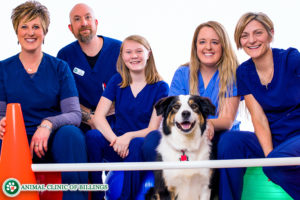
Scheduling an appointment for a laser therapy session at the Animal Clinic of Billings and Animal Surgery Clinic is as easy as picking up the phone, sending us an email, or just stopping by to visit our veterinary clinic in person. Our highly knowledgeable and friendly team of veterinarians, receptionists and technicians can
help answer any questions you have about laser therapy for cats and dogs. Call us today and schedule an appointment for your canine or feline companion to begin experiencing the benefits of what laser therapy can do for your pet!
Let our highly trained and experienced team of veterinarians and veterinary technicians help you keep your pet as happy and healthy as they can be.
406-252-9499 REQUEST AN APPOINTMENT


